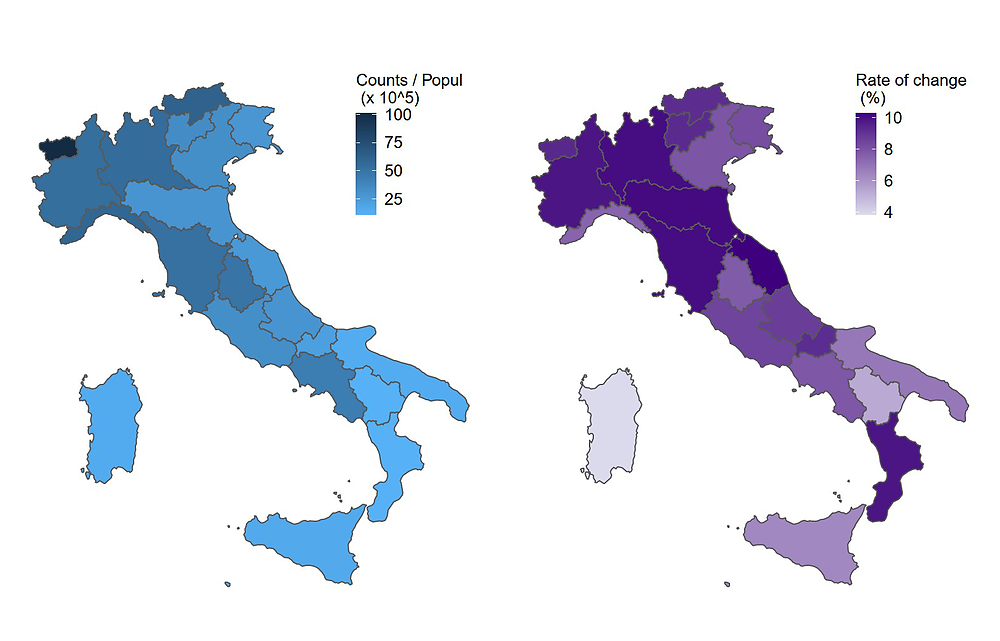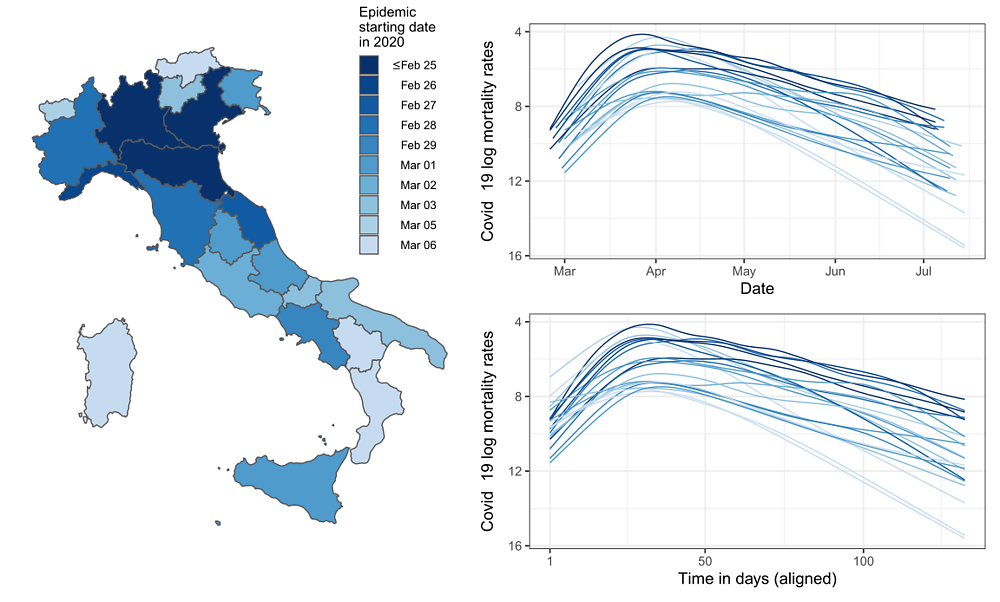Laboratory
Population Dynamics and Sustainable Well-Being
At a Glance
Projects
Publications
Team
Project
Analyzing and Monitoring the Early Spread of COVID-19: A Demographic Perspective
Ugofilippo Basellini, Diego Alburez-Gutierrez, Emilio Zagheni; in Collaboration with Marco Bonetti (Bocconi University, Milan, Italy), Carlo Giovanni Camarda (French National Institute for Demographic Studies, Paris, France)
Detailed Description
The novel coronavirus disease (COVID-19) has hit the world harshly. We provide some demographic insights into the first phases of the COVID-19 pandemic.
This project has three main goals. First, to estimate and visualize the spread of COVID-19 in Italian regions and provinces. To this end, we introduced a new software tool (Bonetti and Basellini 2021).The software is based on open-access coronavirus data provided by the Department of Civil Protection. The data are modeled using standard Poisson regression, with parametric and nonparametric functional forms for the hazard function. The results are readily visualized for each province or region on a map for the entire country. This allows for the dynamic monitoring of the spread of the disease, providing the opportunity to quickly identify risk-areas affected by the pandemic and relocate the use of health care resources across the country. A webpage is dedicated to the visualization of the software’s results.
The second goal is to understand the socioeconomic factors that have contributed to the diverse regional experiences of COVID-19 mortality in a range of contexts. In one study, we analyzed the relationship between the number of COVID-related deaths and a set of explanatory variables at the regional level in Italy. We have found that COVID-19 mortality was negatively associated with the degree of intergenerational co-residence, the number of intensive care unit beds per capita, and delay in the outbreak of the epidemic. Conversely, we did not find strong associations for several variables highlighted in recent research literature (e.g., the population density and the share of the older population) (Basellini and Camarda 2022). In another context, we analyzed the relationship between excess mortality and human mobility in England and Wales, having leveraged novel sources of digital trace data. We have found a robust association between mobility reductions and lower excess mortality, and we predicted that the number of excess deaths could have more than doubled in the absence of the observed mobility reductions (Basellini et al. 2021).
Our third goal is to measure excess mortality, using established demographic forecasting models that allow us to consider correlations among different demographic and geographic groups, or autocorrelations over time. So far, we proposed and employed the Lee-Carter method to compute excess mortality estimates. We illustrated this approach by using weekly age- and sex-specific mortality data for 19 countries, and we documented heterogeneity of excess mortality across countries, sex, and age groups in Europe during 2020 (Vanella et al. 2021). In another study, we documented the levels of excess mortality in Guatemala (Martinez-Folgar et al. 2021).
Covid-19 in Italy

Maps of Italy showing, for each region, the magnitude of newly reported SARS-CoV-2 infections (left) and their rates of change (right) on October 27, 2020. © Bonetti and Basellini (2021)
Covid-19 mortality rates in Italian regions by epidemic onset

Start date of the epidemic by region (left-hand panel) and smoothed Covid-19 log mortality rates over time (right-hand panels): Italy, late February to mid-July 2020. Regions with earlier epidemic outbreaks show on average higher levels of Covid-19 mortality than regions with later outbreaks. © Basellini and Camarda (2022)
Aging, Mortality and Longevity, Statistics and Mathematics
Europe, Guatemala, Italy, United Kingdom
Publications
Basellini, U.; Camarda, C. G.:
Population Studies 76:1, 99–118. (2022)

Basellini, U.; Alburez-Gutierrez, D.; Del Fava, E.; Perrotta, D.; Bonetti, M.; Camarda, C. G.; Zagheni, E.:
SSM-Population Health 14:100799, 1–18. (2021)

Bonetti, M.; Basellini, U.:
Demographic Research 44:12, 307–332. (2021)

Martinez-Folgar, K.; Alburez-Gutierrez, D.; Paniagua-Avila, A.; Ramirez-Zea, M.; Bilal, U.:
American Journal of Public Health 111:10, 1839–1846. (2021)

Vanella, P.; Basellini, U.; Lange, B.:
Genus 77:16, 1–36. (2021)
